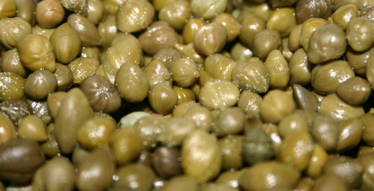Caper
 |
Caper buds must be harvested by hand right before the morning flowering. Their tangy flavor lends piquancy to sauces, condiments, salads and meats. |
These sun-dried buds of the Capparis Spinosa plant are commonly pickled in a vinegar brine. Sprinkled on foods for garnish or incorporated into recipes, their tangy, lemony, salty-sour flavor lends a piquant finishing touch to meats, fish, vegetables, sauces and more.
History
The caper has been known since classical Greek and Roman times when it was called kapparis. The Greeks introduced capers to France around 600 BC.
Varieties and Buying Tips
Capers are typically jarred in brine, but they can also be found salted and sold in bulk. They range in size from the petite nonpareils from Southern France (considered the finest) to the larger, fingertip-sized buds from Italy. You might also find caperberries from Spain that are close to the size of cocktail olives. Larger capers have the strongest flavor, while smaller varieties are more mild.
Storage Tips
Keep brine- or oil-packed capers in the refrigerator for up to nine months (keep the buds covered with liquid). Salt-packed capers can be kept airtight at room temperature for up to six months.
Usage Tips
Before adding to recipes, rinse capers with cold water to remove excess salt. Blot dry with paper towels.
• Garnish martinis with capers instead of olives.
• Add capers to tuna and egg salads.
• Sprinkle on sliced tomato salads, pizza or bagels with cream cheese and smoked salmon.
• Mix with olive oil and lemon juice and drizzle over fish or veal.
• Stir into spaghetti sauce for your own version of pasta puttanesca.
• Add capers at the end of cooking time.
Try one of our favorite caper recipes:
Grilled Snapper Vera Cruz
Suzanne's Chicken Picatta
Salmon Spread
Suggested Pairings
anchovies, artichokes, chicken, cream cheese, eggs, fish, garlic, lemon, liver, olive oil, olives, onions, pork, salmon, spaghetti sauce, tomatoes, tuna, turkey, veal, white wine





